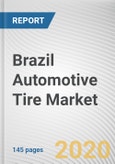Moreover, automobile manufacturers are inclining toward electric and alternative fuel vehicles due to implementation of vehicle emission regulations. The The rise in production of commercial and passenger cars along with the new advanced technology creates a demand for the tire business in the region. For instance, Bridgestone came up with new innovative tires “Ecopia EP500 ologic”.
These tires are based on “Ologic technology”, which uses synergies of large diameter in conjunction with smaller width. Furthermore, this solution improves fuel efficiency by reducing rolling resistance and environmental impacts. In addition, the Continental started offering different categorized tire as their product such as winter, all-seasoned and summer to boost the sales of tire in the Brazil automotive tire market
The Brazil automotive tire market is segmented into season type, rim size, vehicle type, and distribution channel. By season type, it is divided into summer, winter and all-season tires. By rim size, the market is categorized into less than 15 inch, 15 to 20 inch, and more than 20 inch. By vehicle type, it is divided into passenger car, commercial vehicle, electric vehicles, and luxury/premium vehicles. Based on distribution channel, it is classified into OEM, aftermarket, and online sales.
The key players profiled in the report are Bridgestone Corporation, Continental AG, The Goodyear Tire & Rubber Company, Hankook Tire & Technology Co., Ltd., Maxxis International, MICHELIN, Nokian Tyres plc., Pirelli Tyre C. S. p. A. (China National Chemical Corporation), Sumitomo Rubber Industries Ltd., The Yokohama Rubber Co., Ltd., and Toyo Tire Corporation.
KEY BENEFITS FOR STAKEHOLDERS
- This study presents analytical depiction of the Brazil automotive tire market along with the current trends and future estimations to depict the imminent investment pockets.
- The overall market potential is determined to understand the profitable trends to enable stakeholders gain a stronger foothold in the market.
- The report presents information related to key drivers, restraints, and opportunities with a detailed impact analysis.
- The current market is quantitatively analyzed from 2019 to 2027 to highlight the financial competency of the market.
- Porter’s five forces analysis illustrates the potency of the buyers and suppliers.
KEY MARKET SEGMENTS
KEY MARKET SEGMENTS
By Season Type
- Summer
- Winter
- All season
By Rim Size
- Less than 15 inch
- 15-20 inch
- More than 20 inch
By Vehicle Type
- Passenger Cars
- Commercial Vehicles
- Electric Vehicles
By Distribution Channel
- Original Equipment Manufacturers (OEMs)
- Aftermarket
- Online Sales
Key Players
- Bridgestone Corporation
- Continental AG
- The Goodyear Tire & Rubber Company
- Hankook Tire & Technology Co., Ltd.
- Maxxis International
- MICHELIN
- Nokian Tyres plc.
- Pirelli Tyre C. S. p. A. (China National Chemical Corporation)
- Sumitomo Rubber Industries Ltd.
- The Yokohama Rubber Co., Ltd.
- Toyo Tire Corporation
Table of Contents
Methodology
The analyst offers exhaustive research and analysis based on a wide variety of factual inputs, which largely include interviews with industry participants, reliable statistics, and regional intelligence. The in-house industry experts play an instrumental role in designing analytic tools and models, tailored to the requirements of a particular industry segment. The primary research efforts include reaching out participants through mail, tele-conversations, referrals, professional networks, and face-to-face interactions.
They are also in professional corporate relations with various companies that allow them greater flexibility for reaching out to industry participants and commentators for interviews and discussions.
They also refer to a broad array of industry sources for their secondary research, which typically include; however, not limited to:
- Company SEC filings, annual reports, company websites, broker & financial reports, and investor presentations for competitive scenario and shape of the industry
- Scientific and technical writings for product information and related preemptions
- Regional government and statistical databases for macro analysis
- Authentic news articles and other related releases for market evaluation
- Internal and external proprietary databases, key market indicators, and relevant press releases for market estimates and forecast
Furthermore, the accuracy of the data will be analyzed and validated by conducting additional primaries with various industry experts and KOLs. They also provide robust post-sales support to clients.

LOADING...








